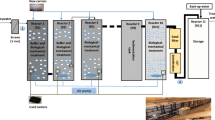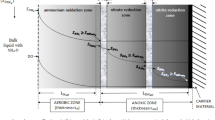Abstract
A mathematical model for a three phase fluidized bed bioreactor (TFBBR) was proposed to describe oxygen utilization rate, biomass concentration and the removal efficiency of Chemical Oxygen Demand (COD) in wastewater treatment. The model consisted of the biofilm model to describe the oxygen uptake rate and the hydraulic model to describe flow characteristics to cause the oxygen distribution in the reactor. The biofilm model represented the oxygen uptake rate by individual bioparticle and the hydrodynamics of fluids presented an axial dispersion flow with back mixing in the liquid phase and a plug flow in the gas phase. The difference of settling velocity along the column height due to the distributions of size and number of bioparticle was considered. The proposed model was able to predict the biomass concentration and the dissolved oxygen concentration along the column height. The removal efficiency of COD was calculated based on the oxygen consumption amounts that were obtained from the dissolved oxygen concentration. The predicted oxygen concentration by the proposed model agreed reasonably well with experimental measurement in a TFBBR. The effects of various operating parameters on the oxygen concentration were simulated based on the proposed model. The media size and media density affected the performance of a TFBBR. The dissolved oxygen concentration was significantly affected by the superficial liquid velocity but the removal efficiency of COD was significantly affected by the superficial gas velocity.
Similar content being viewed by others
References
Schügerl, K. (1997) Three-phase-biofluidization—Application of three-phase fluidization in the biotechnology—A review.Chem. Eng. Sci. 52: 3661–3668.
Miura, H. and Y. Kawase (1997) Hydrodynamics and mass transfer in three-phase fluidized beds with non-Newtonian fluids.Chem. Eng. Sci. 52: 4095–4104.
Chatib, B., A. Grasmick, S. Elmaleh and R. B. Aim (1981), Biological wastewater treatment in a three-phase fluidised-bed reactor. p. 192–204 In: P. F. Cooper and B. Atkinson (eds.),Biological Fluidized Bed Treatment of Water and Wastewater. Ellipse Horwood Limited, Chichester, UK.
Sutton, P. M., J. Hurvid, and M. Hoeksema (1999) Biological fluidized-bed treatment of wastewater from byproduct coking operations: Full-scale case history.Water Environ. Fed. 71: 5–9.
Chang, H. T., B. E. Rittmann, D. Amar, R. Hein, O. Ehlinger, and Y. Lesty (1991) Biofilm detachment mechanisms in a liquid-fluidized bed.Biotechnol. Bioeng. 38: 499–505.
Choi, J. W. (1983) A theoretical study of the oxygen reaction rate in a three-phase fluidized bed biofilm reactor, M. S. Thesis, Sogang University, Korea.
Mulcahy, L. T., W. K. Shieh, and E. J. Lamotta (1980) Simplified mathematical models for a fluidized bed biofilm reactor.AIChE Symp. Ser.; Water: 273–285.
Shieh, W. K., P. M. Sutton, and P. Kos (1981) Predicting reactor biomass concentration in a fluidized-bed system.J. Water Pollut. Control Fed. 53: 1574–1584.
Shieh, W. K., A. M. Asce, and L. T. Mulcahy (1981) Fluidized bed for biological wastewater treatment.J. Environ. Eng. Division. EE1: 293–295.
Bailey, J. E. and D. F. Ollis (1986)Biochemical Engineering Fundamentals, 2nd ed. McGraw-Hill Book Co. New York, NY.
Shieh, W. K. (1980) Suggested kinetic model for the fluidized-bed biofilm reactor.Biotechnol. Bioeng. 22: 667–676.
Andrews, G. (1988) Effectiveness factors for bioparticles with monod kinetics.Chem. Eng. J., 37: B31-B37s.
østergaad, K. and P. Fosbol (1979) Transfer of oxygen across the gas-liquid interface in gas-liquid fluidised beds.Chem. Eng. J. 3: 105–111.
Dakshinamurty, P., V. Subrahmanyam, and J. N. Rao (1971) Bed porosities in gas-liquid fluidization.I. & E. C. Des. Develop. 10: 322–328.
østergaad, K. (1968), Gas-liquid-particle operations in chemical reaction engineering. p. 71–137.In: T. B. Drew, G. R. Cokelet, J. W. Hoopes. Jr and T. Vermeulen (ed.)Adv. Chem. Eng. Vol. 7, Academic Press Inc., New York, NY.
Pavlica, R. T. and J. H. Olson (1970) Unified design method for continuous-contact mass transfer operations.I. & E. C., 62: 45–58.
Shah, Y. T., (1979)Gas-Liquid-Solid Reactor Design, McGraw Hill Book Co. New York. NY.
Wehner, J. F. and R. H. Wilhelm (1956) Boundary conditions of flow reactor.Chem. Eng. Sci. 6: 89–93.
El-Temtany, S. A., Y. O. El-Sharnoubi, and M. M. El-Halwagi (1979) Liquid dispersion in gas-liquid fluidized Beds.Chem. Eng. J. 18: 151–159.
Fan, L. S. (1989)Gas-Liquid-Solid Fluidization Engineering, Butterworths, Boston, MA.
Williamson, K. and P. I. McCarty (1976) A model of substrate utilization by bacterial films.J. Water Pollut. Control Fed. 48: 281–296.
Maron, M. J. (1982)Numerical Analysis; A Practical Approach, Macmillan, New York, NY.
Metzler, C. M., G. L. Elfring and A. J. McEwen (1974) A package of computer programs for pharmacokinetic modeling.Biometrics, 30: 562–563.
Author information
Authors and Affiliations
Corresponding author
Additional information
An erratum to this article can be found online at http://dx.doi.org/10.1007/BF02931915.
Rights and permissions
About this article
Cite this article
Choi, JW., Min, J., Lee, WH. et al. Mathematical model for a three-phase fluidized bed biofilm reactor in wastewater treatment. Biotechnol. Bioprocess Eng. 4, 51–58 (1999). https://doi.org/10.1007/BF02931914
Issue Date:
DOI: https://doi.org/10.1007/BF02931914




